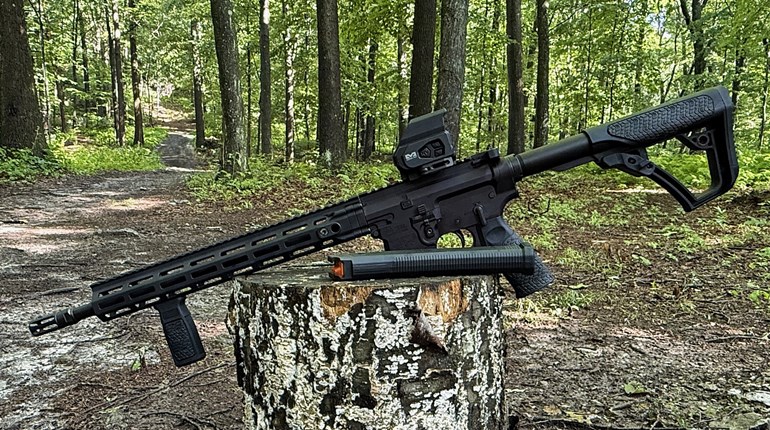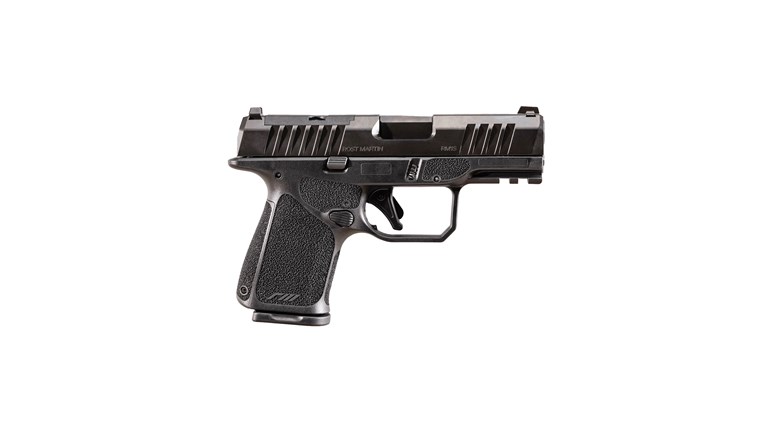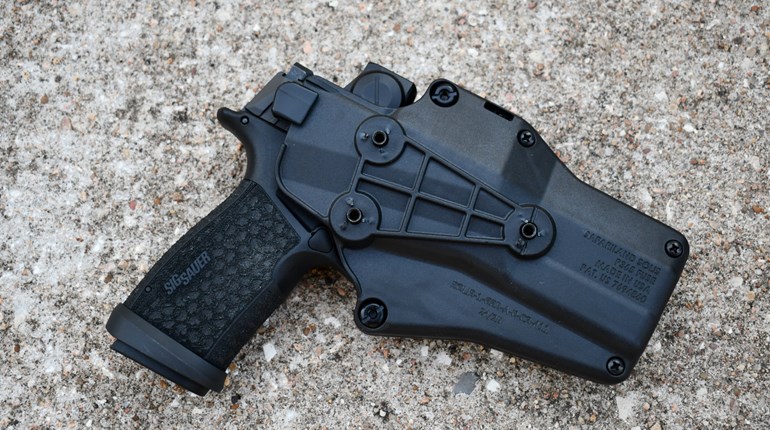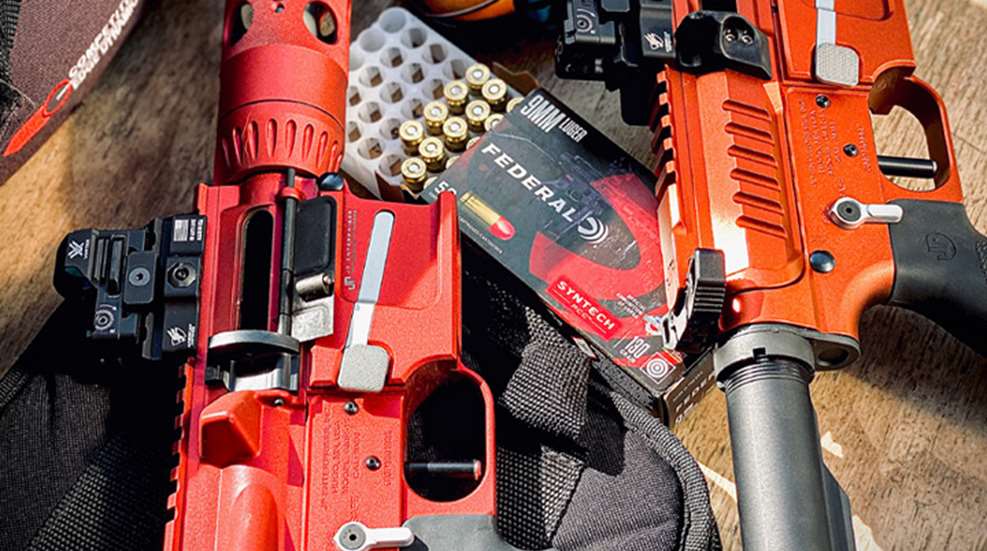
As more and more shooters wade into the PCC division, the options available for competition continue to evolve at a rapid rate. JP Enterprises has a number of horses in this race, including this pair that arrived at Parabellum and attracted a fair amount of attention from the crowd lingering in the show room. The Doublemint Twins may have drawn a bigger crowd, but these JP Carbines were definitely attention-grabbers. The first GMR-15 came in a shade of red somewhere between pink and salmon labeled as "Titan Gun Candy," and the other came in a bronze or burnt orange color called "Ember Gun Candy" on the invoice. These two carbines were sharp-looking and caught the eye of anyone and everyone in the area. (For our purposes, they will be referred to as red and orange in this review.)
JP carbines were developed with law enforcement needs in mind. These rugged carbines are lightweight, well-constructed and reliable; they accept Glock G17 magazines, which makes a great deal of sense as many departments carry Glock pistols in their holsters. The 9mm rounds through a carbine can be effective and accurate out to 100 yards if the shooter has the skill to make it happen. The cost savings of 9mm rounds compared to .223 Rem. is substantial and should allow for more training for the dollar. The more training and practice the better both for the officers wanting to go home at the end of the shift, and for the civilians who need assistance dealing with a lethal threat to hearth and home.
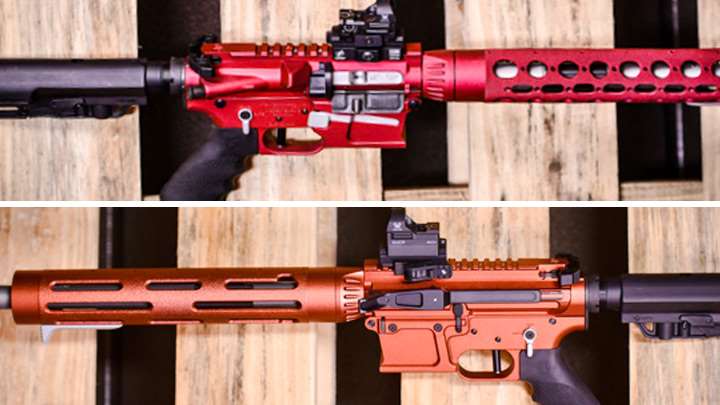
Homeowners looking for an effective tool to defend their home can find a great solution with these carbines as well. In addition, the GMR-15 is a great option for USPSA shooters looking to have fun on the weekends, trying to reach the top of the scoresheet. The GMR-15 can fit a combination of roles. Shoot the GMR-15 in USPSA and get to know the controls of the carbine that you will reach for on the job or in defense of the home; shoot the GMR-15 in competition and build the skills that can be used in more serious applications.
The red GMR-15 included an adjustable Mission First tactical stock, and a rubber pistol grip manufactured by Hogue. The receiver accepts Glock magazines, and the magazine release is large and located on the right side of the gun, meant to be pressed with the trigger finger. The first time these models were used in live fire, it was easy to hit the magazine release and have fast reloads. The safety is ambidextrous and in the normal location for the AR platform. There is a deflector at the rear of the ejection port that directs brass away from the shooter. The bolt release is located in the traditional place and traditional in size. There are six inches of rail on top of the receiver for mounting sights or optics; the charging handle is large and easy to grasp in a hurry.
JP offers several different trigger options that you can select from while visiting the rifle builder program on their website. These models came with “roller trigger,” a design from Tom Fuller of Armageddon Gear that helps to assist in a straight back linear release of the trigger. The trigger sits vertically inside the trigger guard and rolls under the trigger finger. The trigger breaks crisply at around three to three and a half pounds of pressure. The trigger has a really nice positive reset. The fact that the trigger rolls is a great feature, allowing the finger to move smoothly as the trigger is pressed and reducing the amount of cross pressure on the trigger during the press.
This mechanical advantage allows the trigger to move straight to the rear, even if the shooter is not pressing completely straight back and allows a wider variation of what is an acceptable trigger press. If you want to buy all of the points on the target that you can buy, this trigger is the way to do it. A couple of people handling the gun at the counter at Parabellum said they were not sure about this rolling trigger. The difference in feel between this JP rolling trigger and a traditional trigger is immense, but so are the results on target. Shooting the carbine in a match with zero trigger time prior to the match did not create a problem related to the trigger at all. Embrace the rolling trigger and embrace the improved results on the targets. The rolling trigger is a great feature.
The carbine has a full-length handguard with a silver handguard brace at the muzzle end that allows the shooter to comfortably press the carbine back into the shoulder. The brace has pyramid shaped texture on the surface that contacts the hand, and holds the hand firmly in place. The handguard, which sparkles when out in the sun, has holes for attaching gear and accessories. The barrel is five and half inches long with a 1:10-inch twist in 9mm. The barrel is fully shrouded with an overall length of 16 inches. The shroud is both pinned and welded into place. This short barrel with the shroud makes this carbine very light. But, how much will this matter on the range?
The orange GMR-15 has the Raptor side charger built into the left-hand side of the receiver. This feature is obviously designed for USPSA competition and allows for the bolt to be racked without dismounting the carbine from the shoulder. It is a very fast and smooth feature that is both functional and cool. The orange GMR-15 also has a billet upper receiver that gives it more heft than the red GMR-15. The side charge handle is only available with the billet upper. The orange model was by no means heavy, but the red model was noticeably lighter. Handling them back to back on the range this was noticeable. Jake Marten’s older GMR-15 with the full length barrel was quite a bit heavier in comparison to the orange and red versions.
For testing purposes, a Vortex Razor was placed on both carbines. Both were run through two club matches without a malfunction. The classifier on the evening was Can You Count, which has two mandatory reloads in the course of fire and allowed for a test of the magazine release under pressure. The reloads went fine, and the controls were easy to reach on the clock. It seems the carbine will fire every single time you press the trigger, and the extra shot also resulted in an extra hit. Can you count? The answer was no. Can you reload this JP quickly and get back on the trigger for six shots? The answer was yes. The carbine did its part.
Martens shot PCC at WVPPS’s monthly club match on March 15. Temperatures were in the high 30s as the match started and the sun was not out for the first stage. Several guns were not functioning, presumably due to the cold. Jake had zero problems with the gun running throughout the match, and his match performance was good enough to secure the win. The carbine had no problem firing at a high rate to keep pace with Jake and his finger. The only thing faster than his traffic finger is his trigger finger. The light weight of these carbines made them very handy for negotiating field courses, and getting into and out of tight shooting positions.
As the Governor of Indiana was giving a speech to issue a stay at home order, Martens and I arrived at the Riley Conservation Club to put these carbines to the test. We decided to start with some “draws.” The start position was loaded with stock on belt, safety on, both hands on the carbine. Starting with the orange carbine, Martens’ times on five attempts ranged from 1.22 seconds down to 1.03 seconds, and mine ranged from 1.02 seconds to 0.98. Draws with the red carbine for Martens ranged from 1.19 seconds down to 0.99 seconds, and mine were 1.01 seconds down to 0.88. The light weight of the red carbine could be the difference, or it could be we were warmed up. All of the hits were Alphas at ten yards except for one shot. Both carbines pointed pretty naturally. Martens had one malfunction on his second draw attempt with the orange carbine.
The next drill was six shots, with a pair of shots on three different targets. The first target on the left was at a full 20 yards, and the second two targets were at 35 yards. The targets were spread out nearly 12 yards wide. We ran the drill four times each with each of the carbines. Marten’s runs with the orange carbine were 3.15, 2.71, 2.54 and 2.55 seconds, and mine were 2.85, 2.87, 3.02 and 2.78 seconds. Marten’s times with the red carbine were 2.68, 2.58, 2.43 and 2.54 seconds and mine were 2.94, 2.95, 2.65, and 2.24 seconds. The faster times are being achieved with the lighter carbine; this is what the FBI calls a clue. Perhaps we need not wonder why everyone wants a lighter PCC.
There was a second malfunction with the orange carbine. Martens was using the same magazine both times it happened. He set the magazine aside, and we have no more malfunctions with either gun. You decide if it was the magazine or not.
The next drill used the same target array, but we added a 12-inch plate to the right side of the array at a distance of 20 yards. This plate added about eight more yards to the width of the array. We started with a single shot to the plate and then two shots to the remaining targets, this time transitioning from right to left. Martens' times with the orange gun were 3.60, 3.41, 3.33 and 3.41 seconds and mine were 3.88, 3.66, 3.40 and 3.43 seconds. The trend of faster times with the red gun continued on this drill. Martens had times of 3.45, 3.17, 3.30 and 3.30 seconds, and my times were 3.71, 3.36, 3.74 and 3.42 seconds with the red.
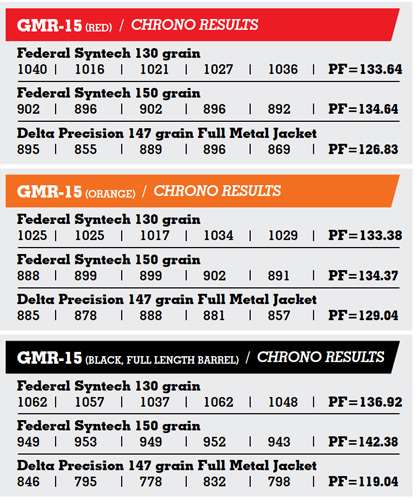
We decided to do some unloaded table starts with each gun to test how easy it would be to use the charging handle or the Raptor side charger on these carbines. We used a single paper target at 10 yards, and started with the magazine on the table and hands at sides. We did four starts each with a small magazine and five with a large magazine. Jake started out with the orange carbine, which has the Raptor side charger. We laid the carbine with the charger down to facilitate gripping the gun faster. Martens' times with the large magazine ranged from 3.58, 2.58, 2.79 and 2.75 seconds, and with the same carbine and small magazine his times were 2.73, 2.97, 2.35 and 2.51 seconds. The smaller magazines seemed to provide a little bit of an advantage and that is not a surprise. My times with the orange carbine and the large magazine were 3.45, 2.78, 2.88 and 2.68 seconds, and with the small magazine they were 3.02, 2.89, 2.55 and 2.60 seconds.
We repeated the process with the red carbine, which is the lighter model, but lacks the side charging handling. The charging handle on this model is in the traditional location but it is sizeable to grasp in a hurry and the following times demonstrate that fact. Martens’ red gun times with the large magazine were 3.95, 2.85, 2.83 and 2.71 seconds, and the small magazine times were 2.34, 3.11, 2.36 and 2.32 seconds. My times with the large magazine were 3.05, 2.61, 2.49 and 2.58 seconds, and small magazine times were 2.75, 2.58, 2.40 and 2.26 seconds. Perhaps these numbers are a testament to the greatness of the standard charging handle on the red carbine.
Neither Martens nor I are serious PCC shooters, and our lack of familiarity with PCC is obvious. We have shot and run a number of matches and had many opportunities to observe PCC shooters over the last few years. Unloaded starts and reloads, in my observations, are a weakness for many PCC shooters. We did not get any familiarization with these carbines, but thought that things went pretty well. Being able to load and reload them pretty smoothly speaks volumes about the size and location of the controls. These GMR-15 carbines are shooter-friendly, and the match and range session was actually fun.
While shooting controlled pairs on the drills, the red dot stayed on target throughout the process, and did not disappear from view as it often does with a pistol. The dot did lift enough so that shot calling could be achieved at speed. GMR-15 has evolved the last few years and, as good as the GMR-15 was a couple of years ago it is even better today. It is easy to recommend the GMR-15 line as quality items. You will not be disappointed.
Article from the May/June 2020 issue of USPSA’s FrontSight magazine. Photos by Isabel Martens.
See more: Top USPSA Production Handguns In 2019














